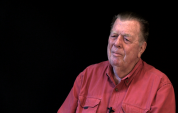8:59 | Reporter Joe Galloway wanted to get to the action but the airspace around the battle was closed. After he got a fellow crazy Texan named Ray Burns to fly him in, he was told to go see camp commander Charlie Beckwith. The Major needed everything but a reporter, but he immediately put Joe to work on a machine gun.
Keywords : Joe Galloway central highlands mountain special forces Plei Mei Cambodia Texas pilot Ray Burns mortar Montagnard Charles Beckwith Chargin' Charlie Delta Force reporter machine gun 105mm 1st Cavalry M-16

Joe Galloway was discouraged with college and was on his way to enlist when he drove by the daily newspaper's building, decided to stop, and asked for a job. Thus began a long career which would take him far from home.
As he flew into Vietnam for the first time, reporter Joe Galloway watched a Buddhist monk dragged off the plane and arrested. That caught his attention, as did the rubber stamp customs process, but what really woke him up was what happened when he was immediately put onto a helicopter and taken into the field.
After his first trip to the front in Chinos and loafers, reporter Joe Galloway acquired a proper field kit and began observing and reporting on the strange war that was Vietnam. In Pleiku, he jumped off the plane because he saw bodies being stacked and was soon meeting up with a South Vietnamese unit. Their advisor, a new Major named Norman Schwarzkopf, would prove to be a valuable contact.
Reporter Joe Galloway was with COL Hal Moore and the 1st Cavalry Division, operating in the central highlands of Vietnam, when word came of enemy movement in the Ia Drang Valley. He waited with a group of correspondents, including Peter Arnett, all trying to get to the front. But it was Galloway who finessed a ride into the pages of history at the battle.
When the battle of Ia Drang started, reporter Joe Galloway flattened until he heard Sergeant Major Basil Plumley bellow, "Can't take no pictures laying there on the ground, Sonny." Galloway not only got up, he was a player in the biggest battle of the war, with Custer's old outfit in a river valley surrounded by a vastly larger number of hostiles.
Joe Galloway was right in the middle of the Ia Drang battle and witnessed the withering artillery and air power that felled so many thousands. Later, Galloway asked North Vietnam's General Giap what he thought about losing so many men. The answer surprised him.
The Ia Drang veterans were visiting North Vietnamese veterans of the same battle. When Bill Beck drew a diagram of his machine gun position in the battle, the North Vietnamese officer at the table turned white.
After washing off the grime of battle from Ia Drang, Joe Galloway could not believe what he was hearing as General Westmoreland stood on the hood of a jeep and tried to give a rousing speech. Then, in a press conference, when another General would not call a disastrous ambush an ambush, he stood and spoke his mind.
Tired of the dying and killing, reporter Joe Galloway went back to Tokyo to cover Asia for UPI, but he would find himself going back to Vietnam three more times to document the dark descent into chaos.
Back home in the States, reporter Joe Galloway was disturbed by the treatment of returning Vietnam vets and eager to tell his story about the Ia Drang battle. A new job with U.S. News & World Report allowed him to do that and it resulted in a best selling book authored by him and Hal Moore, the American commander at the battle.
Joe Galloway's best seller about the Ia Drang battle hit close to home for many veterans, and it inspired many to open up about their experiences. Then it became a big Hollywood film with a pretty good reality/fantasy ratio.
Following the harrowing experience of covering the Vietnam war, Joe Galloway spent three years in Cold War Moscow. He had to play private eye just to get mundane information and he playfully told them about some advice he was going to give Washington after he left.
His chance meeting with Norman Schwarzkopf in Vietnam proved to be a lucky break for reporter Joe Galloway when he went to cover Desert Storm. Schwarzkopf was a little higher up in the food chain by then, so Joe was too. Nothing like a letter from a General in your pocket.